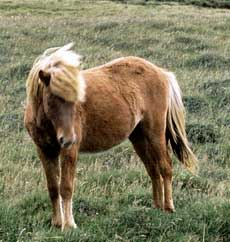|

 Sizes and Scales: Ponies are 14.2 hands (abbreviated hh) (1.47 m) at the withers or smaller, while a horse is anything taller than 14.2 hh at the withers. Sizes and Scales: Ponies are 14.2 hands (abbreviated hh) (1.47 m) at the withers or smaller, while a horse is anything taller than 14.2 hh at the withers.
What's in a Name? The term "pony" can be used generally for any small horse, regardless of its actual measurements. It is interesting to note, however, that some equine breeds are not considered ponies, even if they are under 14.2 hh, because of their fiery temperament.
All For Show: For showing purposes, ponies are grouped into small, medium, and large sizes. Small ponies are 12.2 hh and under, medium ponies are over 12.2 but no taller than 13.2 hh (1.27 to 1.37 m), and large ponies are over 13.2 hh but no taller than 14.2 hh (1.37 to 1.47 m).
Note, however, that miniature horses are not the same as ponies. A miniature horse is in fact much smaller, required to be no taller than 8.2 hh (86cm) at the withers. There are also miniature pony breeds.

Wild Ponies? There are several wild breeds of pony, and these have often been captured and bred for various purposes, especially in Britain and Ireland.
 These wild breeds along with domestic breeds were used as "pit ponies" hauling loads of coal up from the mines, for freight transport, as children's mounts and for entertainment, and later as competitors and performers in their own right. They were also ridden (and continue to be ridden) by adults, as ponies are usually very strong. These wild breeds along with domestic breeds were used as "pit ponies" hauling loads of coal up from the mines, for freight transport, as children's mounts and for entertainment, and later as competitors and performers in their own right. They were also ridden (and continue to be ridden) by adults, as ponies are usually very strong.
Ponies are often said to be mean, untrustworthy, spooky or devious. Properly trained ponies can be gentle, and are appropriate mounts for children who are learning to ride.
The Riding Pony was developed in the United Kingdom, and was such a success that it is now bred all over the world. They are excellent show ponies. The breed is an extremely elegant animal, more like a small horse than a pony. It has a small head and small, neat ears.
They are compact, with sloping shoulders and a narrow front. Their feet are tough and they possess strong limbs. They are well-proportioned with comfortable gaits and free-flowing movement.
What's Your Type? There are three types of ponies:
* The show pony: super-elegant miniature show hack with pony features
* The show hunter: similar to the show pony, but with more substance
* The working hunter: stockier, and more workmanlike
Shetland ponies, also known as shelts, are small (on average up to 42 inches to the wither) but strong for their size. The Shetland Pony originated from the Shetland Islands - North East of Scotland.
 The ancient ponies' roots are unknown, though it is believed that they are related to the ancient Scandinavian ponies from when the islands were joined with Scandinavia The ancient ponies' roots are unknown, though it is believed that they are related to the ancient Scandinavian ponies from when the islands were joined with Scandinavia
(up until 8000 BC).
They were probably influenced by the Celtic Pony, taken by the Celts between 2000 and 1000 BC. The harsh climate and scarce food developed the ponies into extremely hardy animals. They were first used for carrying peat and ploughing. Then, in the mid-19th century, when laws were passed prohibiting children from working in coal mines, thousands of Shetlands traveled to Mainland Britain to be 'pit ponies,' working underground their whole lives
hauling coal.
Versatility in a Pony: The United States mid-west coal mines also imported some of these animals. The Shetland Pony Stud Book Society was started in 1890 to maintain purity and encourage high-quality animals. In 1956, the Shetland Islands Premium Stallion Scheme was formed to subsidize high-quality registered stallions to improve the breeding stock. Today, Shetlands are used as children's ponies and are also featured in the Shetland Pony Grand National, galloping around the course with their young jockeys.
In Shetland Shape: Shetland Ponies are hardy and strong due to the fact that the breed evolved in the harsh conditions of the Shetland Islands. Even possibly the strongest breed relative to their size, and one of the toughest breeds of pony in the world. They are also especially long-lived. They can be almost every color, but are mainly black, chestnut, bay, brown, gray, palomino, dun, roan, cream, champagne and pangaré. They should not be spotted. In appearance, Shetlands have a small head, sometimes with a dished face, wide spaced eyes and small, alert ears. The original breed has a short, muscular neck, compact, stocky bodies, and short, strong legs and a shorter than normal cannon bone in relation to their size.
The Connemara Pony is a hardy breed from Ireland, and is the ultimate pony sport horse, excelling at the top levels of most FEI disciplines. Strong and sturdy with a short back and sloped, muscular croup. The hindquarters are powerful. The shoulder is sloped and long, so they have a good stride length, and the pony has short, strong cannons and hard feet. The Connemara has a fine head with small ears and a straight profile set on a well-arched neck. They stand between 12.2 and 14.2 hands high, although some are taller and therefore not technically ponies. The breed comes in gray, bay, brown, black, dun, chestnut, and occasionally roan. The ponies are steadfast, but gentle. They are excellent sport ponies, being nimble, agile, and fast. The ponies are tough, and possess great endurance.

All text is available under the terms
of the GNU Free Documentation License
|